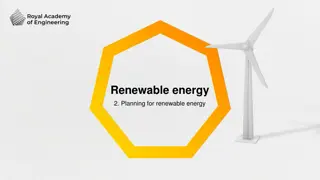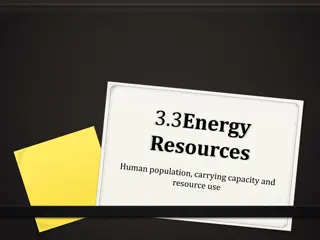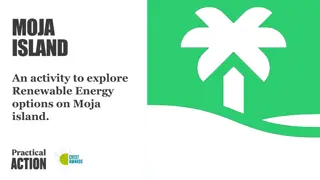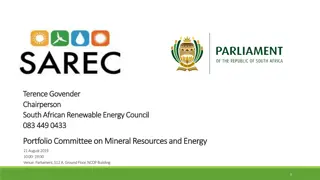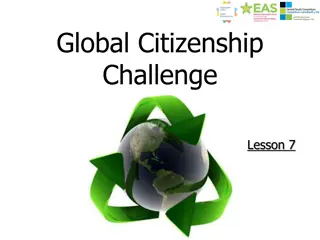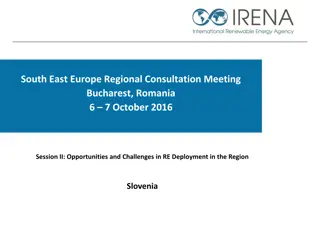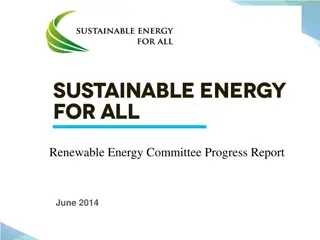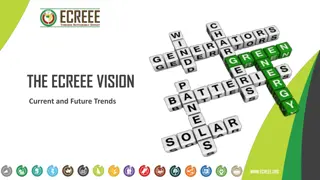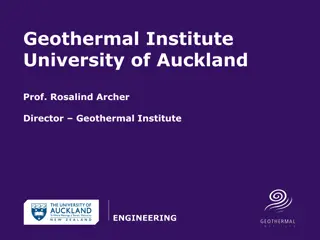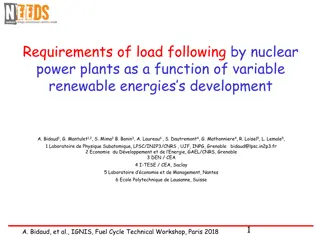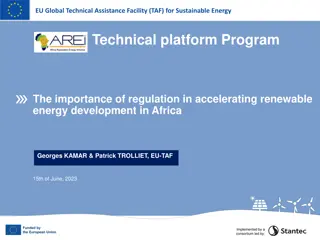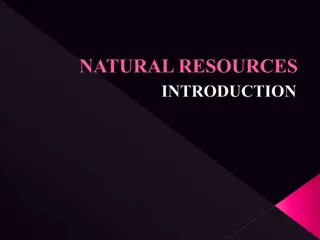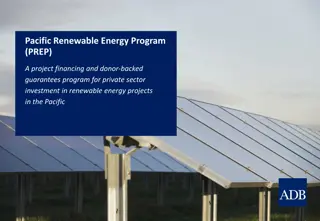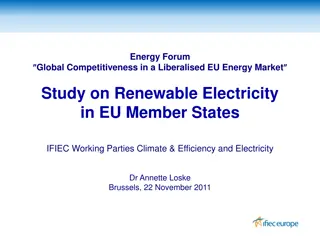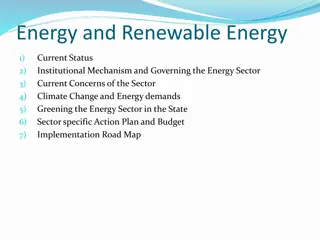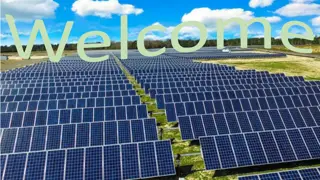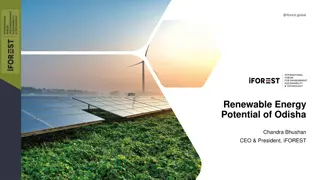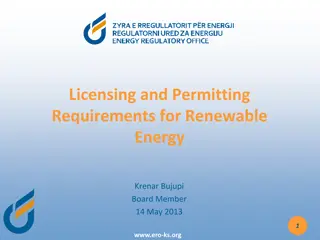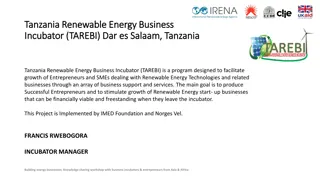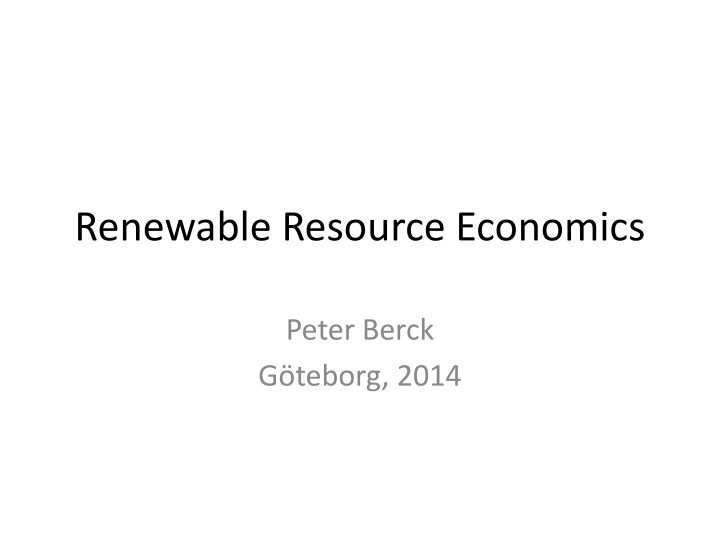
Renewable Resource Economics - Conservation and Management
Explore key concepts in renewable resource economics, such as open access, optimal resource models, extinction risks, and common property management. Learn about the Tragedy of the Commons, the impact of pollution as an externality, and strategies for sustainable resource use.
Download Presentation

Please find below an Image/Link to download the presentation.
The content on the website is provided AS IS for your information and personal use only. It may not be sold, licensed, or shared on other websites without obtaining consent from the author. If you encounter any issues during the download, it is possible that the publisher has removed the file from their server.
You are allowed to download the files provided on this website for personal or commercial use, subject to the condition that they are used lawfully. All files are the property of their respective owners.
The content on the website is provided AS IS for your information and personal use only. It may not be sold, licensed, or shared on other websites without obtaining consent from the author.
E N D
Presentation Transcript
Renewable Resource Economics Peter Berck G teborg, 2014
Outline 1. Open Access Intro. 2. ODE s in the plane and the Schaefer model. 3. Optimal Renewable Resource Models. 4. Extinction. 5. Poaching. 6. LP and Dual: A graphical tour. 7. The Forest Model 8. Forest Policy. 9. Forest and Climate.
Examples Examples Grazing Pollution Carbon Sink Aquifers Forest Charcoal Fishing/poaching Ideas Anyone can come and take the resource== open access Zero price for the resource Externality Common Property and cooperation, rules. Coase, create a market.
Grazing Garret Hardin. Tragedy of the Commons.
Common Property Hardin describes common property, the number of herdsman, E, is constant. The exploitation per herdsman, h, is variable. They do not pay anything to increase h.
Common Property or Externality We often think of pollution as an externality. We do some worthwhile thing, h, and a side effect is that we get some pollution P(h). We can tell the same story as common property. Fixed number of people do good thing, h, which uses clean air services in amount P as an input. The input should be priced or restricted but it isn t. Hence too much of P is used.
Pollution: Air as common property resource or an externality Max utility from economic activity, h, less costs of activity d* h, (private) Economic activity emits pollution, P, (externality) or uses up P units of air. (common property) P causes damage, D. Max U(h)- d h private typical agent, one of E such. Max U(h) d h D(h E) public
E and 1 There are E people of which you are one. Your damage is D /E. Total damage summed across people is D . So private is U(h) dh-D(h E)/E And as E gets large The private objective is U(h) dh.
Common Property and Open Access With E fixed and h variable we talk of this as a as common property. E people either overuse the resource or they cooperate. With E variable (whether or not h is variable) we talk of it as open access. This is less manageable as a new person can come in and do as they please. Even if the original people have good agreements on how to manage the resource.
Market solution Public FOC U -d-D =0 Private FOC U -d=0 Make Private into public by charging D for access to clean air (aka garbage collection services). Coase type solution.
Pollution Example: Open Access Cigarette butt disposal in Gothenburg. Costs me nothing to throw on ground. Costs two steps to put it in the trash. Hence I enter the ciggie throwery. Doesn t make big difference given all the other butts. When you add it up over all the individual rational people who do this you get GUNK*, a stinky, ugly mess that everyone including the smokers puts up with.
Carbon Carbon in the atmosphere is a stock pollutant. Or anyone can use the atmosphere s CO2 removal services for free. Y is gdp without carbon use d is the gdp cost of using carbon (mining) Social problem is 0 = + rt max ( ( )) U E t ( ( )) D P t Y dE e dt E P E P
Hamiltonian with costate ( ) = + + ( ( )) U E t ( ( )) D P t H Y dE E P The social optimum is found from the maximum principle and the costate equation. The costate variable is the social value of atmospheric removal services. Open access is when the costate variable is set to zero. Now we operate as if atmospheric services were free.
Water Pumping https://www.youtube.com/watch?feature=pla yer_embedded&v=3rSnf-u0bzc This is a real and very serious problem the world over. Pumping drives down the water table.
Water Model E is extraction which produces value U P is depth D(P) is the unit cost of pumping. R is rainfall.
Water Over time, social problem E D P t rt max ( ( )) U E t ( ( )) e dt E 0 = P R E
With open access to groundwater E(t) is given by U (E)-D= 0. Which drives up P, which drives up D until U-D E = 0. And thereafter E = R. Show that this is not the optimal thing to do.
Forest Log stealing. Charcoal making. Open access means anyone can come and take. Elinor Ostrom looked for solutions where only a small group, perhaps a village, could come and take and the village would evolve rules. This is common property, E is limited. And if they cooperate, h, too will be limited.
Fish and Poaching x stock of fish E number of boats (or hunters), effort. p price, c cost per boat. k catchability constant. Catch h = kEx (special assumption to make it easy, called a Schaeffer fishery. p. 68 C&C)
Entry rule. pkEx cE is instantaneous profit dE/dt is proportional to instantaneous profit
Stock rule dx/dt = f(x) - kEx
Whats wrong? The entrant makes money but drives down the fish stock, which drives down everyone else's catch.
Fishery game Any fish you catch in the first minute are yours. Any fish you catch in the second minute are yours plus you are awarded two extra fish. As those are the baby fish that grew from the original fish in the first minute. Side payments, force majeure, coalitions, etc are perfectly acceptable.
3 Take Aways Open access means the resource is unpriced. Take what you want for free. Pricing solves this. Open Access vs. Common Property Limitation in user numbers opens the door for cooperation. Open access means that the user imposes a negative externality on other users. Takes stuff that should grow and now doesn t grow Leaves stuff that hurts everyone.
Topics Two Equation System Eigen values and vectors General solution Specific solution Approximating a nonlinear system Phase plane Nodes
Linear Ordinary Differential Equations (Linear ODE) = x A x Ax is a matrix, n x n is a column n vector the 'dot' means time derivative. 0 is an initial condition. x( ) = x* Linear in x, derivative only w.r.t. one variable We are looking for an x(t) that obeys the equation.
Unproved theorems 1. Existence. There is a solution to a Linear ODE.* 2. Uniqueness. Through a point, x , there is only one solution to a LODE
Eigen values and vectors. We restrict ourselves to considering only matrices A that have n distinct eigenvectors. There are n linearly independent vectors c and n constants s.t. = Ac c
A solution ciand iare an eigen vector value pair. TRY IT. Show it is a solution. = it x c ( ) t e i i
General Solution n n = = t x x c ( ) t e b b i i i i i = = 1 1 i i The b s are n constants in the complex plane. Show this is still a solution!
Specific Solution Limit ourselves to an initial condition. At t = 0, exp( t) = 1. n = x i i c * b = 1 i C define as the matrix = b ... c c 1 n and = and ... ' a column vector b b 1 n = 1 x Cb b C * * x
Complex Euler s theorem e = i t + cos( ) sin( ) t i t Suggests looking for solutions in terms of sin an cos if the solution is restricted to the real plane.
Indeed One can show that the eigenvectors are a complex conjugate pair, call the real part w and the imaginary part v. These are both vectors. C= w+vi. Im is the imaginary part and re is the real part of . The two solutions restricted to the real plane are ( ( 2 x (t) = e sin(im( ) ) w ) ) ( ) re t w v x (t) = e cos(im( ) ) sin(im( ) ) t t 1 ( ) + re t v cos(im( ) ) t t
The general solution Is just a linear combination of x1 and x2. That is where the parameters come from that one matches to the initial conditions. Notice also that the inside formula is periodic. Every t = 2 pi / im( ) we are back where we started.
Equilibrium. Enlarge the model a little bit so the equilibrium is off of zero = = x x Ax p 1 0 iff x= A p Of course this still works if p=0. Now we have x* the equilibrium
A non linear model = = ( ) with equilibrium 0 is an n-vector. ( *) f x x x f x
Approximating a differential equation We use Taylors theorem to find the values of f(x) near the equilibrium ( ) = + ( ) f x ( *) f x '( *) f x * x x x x x = '( *) f x ( *) d x x = Note that: so.. x dt ( *) d x x ( ) = '( *) f x * x x dt
In which we introduce the phase space THE SCHAEFER FISHERY
Catch h = k E x h is harvest E is trips x is biomass k is a constant Empirical formula that relates catch to trips and biomass Could generalize with a power of x
Biology Stock next period = Stock this period Plus net growth (f(x) ) Growth Recruitment Less natural mortality Less catch dx/dt = f(x) - h
Stock MSY f(x)=gx(1-x/K) f(x) growth x stock
Profits The profits from a boat are Price times Catch Cost p k x c When profits are positive, boats enter When negative, they leave So, in equilibrium profits are zero
2 Equation Model = = E x pkx c ( ) f x kEx
Steady State When the stock does not change over time the fishery is said to have reached steady state. We will investigate steady states.
When Stock Doesnt Change The catch must be exactly the net growth. f(x) = k E x
Steady state E(x) gx(1-x/K) = kEx E = (g/k)(1-x/K)
How Can Profit Be Zero? The catch per trip depends upon the biomass of fish h / E = k x Lower biomass means less catch Profit = Zero p k x c = 0 xopen = c/(pk)

